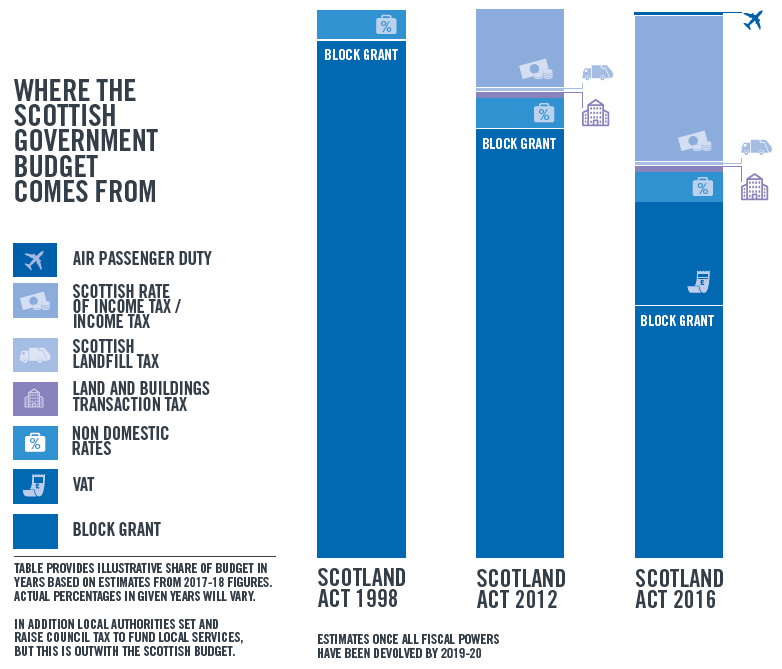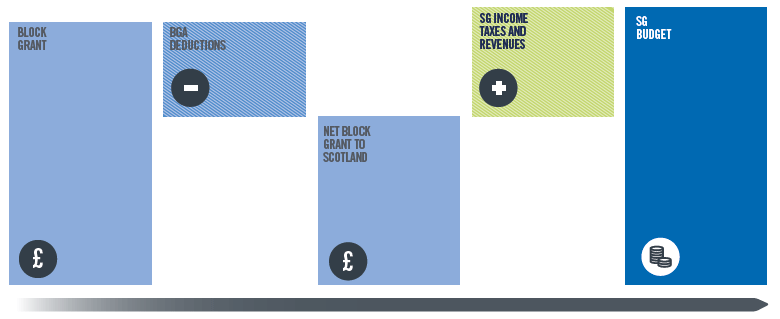The role of income tax in Scotland's budget
A discussion paper that aims to provide useful background to help inform the debate on future use of the income tax powers devolved to the Scottish Parliament.
2 Funding in the Scottish budget
This chapter sets out how spending by the Scottish Parliament is funded following devolution of further tax powers. It also explains the agreement between the UK and Scottish Governments as to how the Scottish Government’s overall budget is set.
2.1 How is Scotland’s funding changing?
Until recently, Scottish Government revenue came almost exclusively via a Block Grant from the UK Government i.e. a budget which was set by the UK Government and Parliament based on spending decisions for England and Wales, which the Scottish Parliament could decide how to spend. The devolution of some tax powers in the Scotland Act 2016 means that decisions made in Scotland now have greater influence over the size of the Scottish Budget. However even when the full set of tax powers agreed in the
Scotland Act 2016 are devolved, the Block Grant set by the UK Government will still make up around 50% of our budget.
Where the Scottish Government budget comes from

In the next financial year from April 2018 to March 2019:
- around 30% of our budget will come from income tax receipts in Scotland
- around 7% will come from other taxes set by the Scottish Parliament including Non- Domestic Rates, Scottish Landfill Tax, Air Departure Tax, Land and Buildings Transactions Tax and Aggregates Levy.
When the Scotland Act 2016 powers are fully devolved, a further 15% of our budget will be based on VAT revenues raised in Scotland, although the rate of VAT will continue to be set by the UK Government.
As a result, less than 40% of our spending power can be directly impacted by tax decisions made by the Scottish Government and Parliament, with income tax being by far the biggest of these. To give an example of what this limitation means in practice, increasing income tax receipts by 5% would raise around an additional £590 million per year, which is just 1.5% of our total budget.
2.2 The Fiscal Framework and the Scottish Government’s budget
With the devolution of new tax powers in 2016, the UK and Scottish Governments agreed a “fiscal framework” [1] that sets the rules for determining the total Scottish Budget. Two of the key principles of that framework are that: i) the Scottish Government’s Budget should benefit in full from policy decisions made by the Scottish Government that increase revenues or reduce expenditure and ii) there should be no detriment to either the Scottish Government or the UK Government budgets as a result of the decision to devolve powers and responsibilities.
To implement that agreement the UK Government will:
- continue to calculate the total Block Grant for the Scottish Government based on the Barnett formula (the formula that calculates how much Scotland should receive relative to UK Government spend in England)
- reduce that grant by an amount equivalent to how much tax per head was raised in Scotland under UK Government policy in the year prior to devolution (this is known as the Block Grant Adjustment ( BGA)). Over time, this adjustment is increased in line with the growth in tax revenues per head raised from equivalent taxes in the rest of the UK. [2]
With new tax powers, how Scotland’s economy performs and the Scottish Parliament’s decisions on tax rates are fundamental in determining tax revenues and whether the Scottish budget is larger or smaller than it would have been without new powers. This approach applies to all recently devolved tax powers, including income tax.
The income tax block grant adjustment ( BGA)

For the Scottish Government and Parliament to agree the Budget Bill each year, there needs to be an agreed overall financial envelope to work within. This depends on the Block Grant received from the UK Government, the forecasts for the BGA produced by the Office for Budget Responsibility ( OBR), and the forecasts of tax revenues raised in Scotland produced by the Scottish Fiscal Commission ( SFC). Put simply, whether the Scottish budget is higher or lower under the new tax powers will come down to the relative performance of tax receipts in Scotland and the UK, which will be heavily influenced by changes in tax policy.
It is inevitable that the forecasts will not exactly match the amounts actually raised in Scotland or the rest of the UK. As a result, when tax returns are finalised they will be compared with the original forecasts. In the case of income tax, the outturn data will become available 15 months after the end of the tax year and the next Scottish Government Budget will be adjusted accordingly.
2.3 The UK Budget in November
The interaction between decisions at UK level and Scottish decisions about tax is central to calculating the impact of the devolved taxes on Scotland’s budget. It is important to note that the partial devolution of income tax and the indexation of the BGA mean, in effect, that whenever there is a change in the devolved tax in the rest of the UK, there is always an implication for Scotland, whether revenue is positive or negative.
The analysis in this paper assumes that in the UK Autumn Budget on 22 November 2017 the Chancellor will:
- raise the Higher Rate Threshold ( HRT) (which applies in the rest of the UK) for income tax in line with the Conservative Party’s manifesto commitment to £50,000 by 2020
- raise the Personal Allowance ( PA) to £12,500 by 2020 in line with the Conservative Party’s manifesto commitment.
Contact
There is a problem
Thanks for your feedback